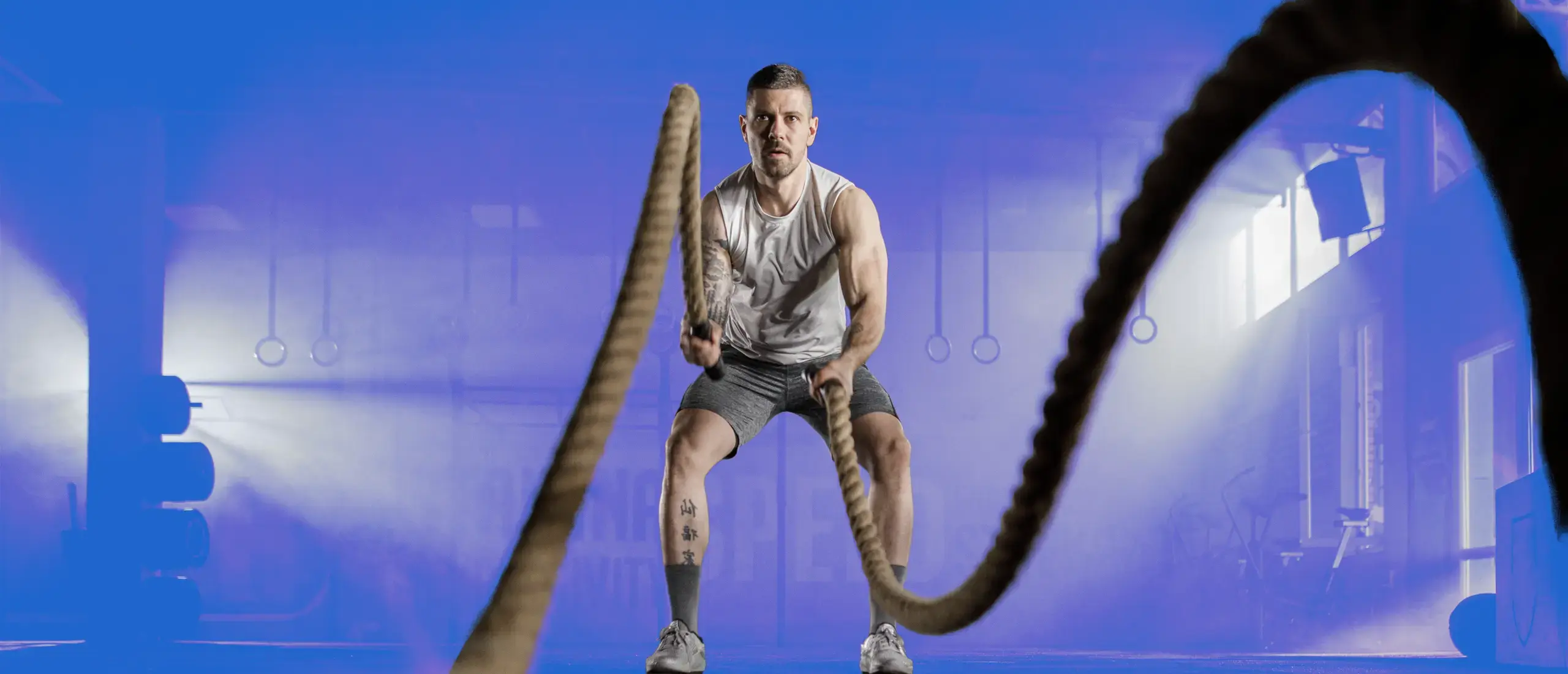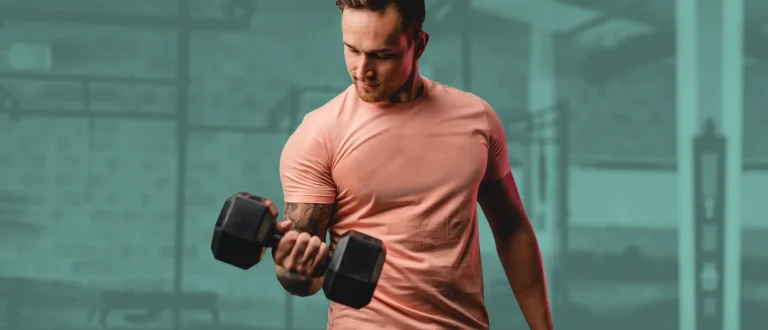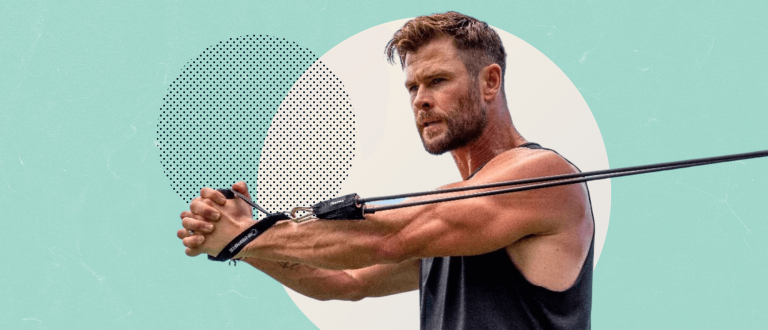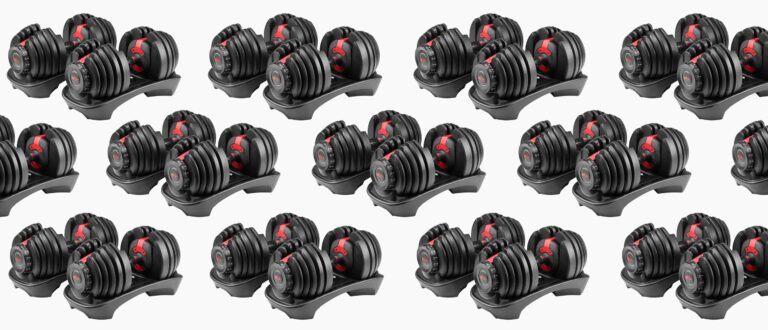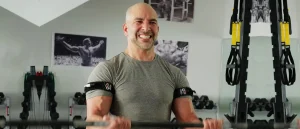8 Surprising Battle Rope Benefits to Level Up Your Next Workout
- By Sydney Bueckert, NASM C.P.T., C.E.S., F.N.S., G.P.T.S.
- November 1, 2023
When you want to get your heart rate up and hit as many muscles as possible, what workout do you turn to? All-out HIIT on the rowing machine? Sprints on the assault bike? Maybe a metabolic workout packed with compound exercises? All of these options are solid. But battle ropes might take the cake when it comes to boosting athleticism, functional fitness, strength, and cardio in one swoop.
What are the benefits of battle ropes, exercises to actually move the needle, and the best ropes money can buy? We tapped personal trainer Daniel McKenna, CPT to find out.
What Are Battle Ropes?
Battle ropes are an everyday tool turned gym accessory. The rope is typically affixed to an anchor (like a squat rack or a heavy kettlebell) with the middle of the rope looped around the anchor, resulting in effectively two ropes: One for each hand.
To use battle ropes, grab an end of the rope in each hand with a neutral grip. From here, typically you’ll keep your feet planted into place, and core engaged as you execute slams, waves, and circles with your hands. But according to McKenna, you can make things more challenging by taking a kneeling stance or plank position, completing reverse lunges, or standing on a bosu ball while continuing to move your hands.
Battle ropes effectively operate as free weights, meaning they can add resistance to any movement in any direction, explains McKenna. They also uniquely allow your body to make quick changes and movement adaptations, working through different planes of motion in a single fluid full-body movement; activating more muscles, and skyrocketing your heart rate in the process.
Benefits of Battle Ropes
The list of battle rope benefits is long. Here are the highlights:
Targets your full body
Battle ropes require multiple major muscle groups to work together to move the ropes and stabilize your body simultaneously—meaning you’ll never train just one muscle group at a time. Most battle rope exercises fire up your back, chest, arms, legs, and core to some degree. Anytime you add battle ropes into the mix, plan for a heavy-hitting, high-effort, full-body workout.
Increases strength and power
Battle ropes are heavy. To move battle ropes—especially during exercises where you have to yank on the weight to make an impact (like slams or Russian twists)—you’ll stretch your explosive power to the limit. “With battle ropes your muscles are also holding constant tension, boosting your muscular endurance or your ability to keep working for even longer,” explains McKenna.
Boosts muscle growth
To build muscle, moving through a full range of motion, lifting heavy loads, and increasing time under tension can help boost gains (1). Battle ropes hit all three, which makes them a great candidate for maximizing your burn—and brawn.
Elevates athletic performance
Battle ropes are a unique tool that allows you to improve basically any motion, per McKenna. “If you’re a golfer, you can work on a swinging motion. If you’re a football player, you can work on a throwing motion. If you’re a hockey player, you can work on a flicking motion,” he adds.
Science agrees. One study found that basketball players who used battle ropes experienced greater gains in shooting accuracy, jump height, core endurance, and chest pass speed when compared to players who only completed standard aerobic training (2).
Increases cardiovascular fitness
If you’ve ever used battle ropes, you know just how intense moving the ropes from point A to point B (and keeping them moving) can be. This makes them a good option for high-intensity sessions like HIIT or circuit training—where you’re working all out for short periods of time.
One study found that battle rope HIIT workouts can increase VO2 max—widely known as the best indicator of cardiovascular performance—in as little as three weeks (3). Participants saw even greater improvements with continued use.
Improves functional fitness
Functional fitness is all about making the way you move throughout the day (i.e. climbing stairs, sitting in a chair, carrying groceries) easier. “The ability to move heavy weight in a fluid motion requires both strength and mobility,” says McKenna. “With repetition, battle rope movements will become easier, and make everyday movements easier too.”
Enhances core stability and balance
The first time you pick up battle ropes you’ll feel them pulling you as you send the heavy weight from side to side, throwing off your balance. To keep your body position stable requires an insane amount of core strength. You’ll also need to call on the intrinsic muscles in your feet and ankles to keep you rooted to the ground. As you continue to use battle ropes, you’ll build stability fast. In turn, that stability translates to more power.
Boosts weight loss
The more muscles an exercise works, the more calories you generally burn doing it. Since battle ropes work most of the major muscle groups in your body (give or take depending on the exercise) they burn loads of calories, and thus, can help with weight loss. Battle ropes exercises are also generally high-intensity in nature, so they’ll spike your heart rate, helping you burn even more.
The Best Battle Rope Exercises
If you’re ready to rip, master the classic battle rope moves below. McKenna recommends starting with four sets of 30 seconds of work to 30 seconds of rest to start. “Once you have it down, advance the classic moves by adding more sets, introducing thicker, heavier ropes, and increasing the work time,” he adds.
Single arm waves
- Stand with your feet slightly wider than shoulder-width apart, rooted to the ground, and an athletic stance with knees slightly bent (like a half squat).
- Hold the ends of the rope at arm’s length in front of your hips with your hands about shoulder-width apart.
- Brace your core and raise and lower one arm, while aiming to keep the other side of your body stable and solid.
- Repeat on the other side.
Alternating waves
- Stand with your feet slightly wider than shoulder-width apart, rooted to the ground, and an athletic stance with knees slightly bent (like a half squat).
- Hold the ends of the rope at arm’s length in front of your hips with your hands about shoulder-width apart.
- Brace your core and begin alternately raising and lowering each arm explosively.
Kneeling waves
- Kneel with both knees on the ground directly below your hips, and shins on the ground with feet directly behind you.
- Hold the ends of the rope at arm’s length in front of your hips with your hands about shoulder-width apart.
- Engage your core and keep your chest up as you raise and lower both arms at the same time.
- Repeat.
Rope slams
- Stand with your feet slightly wider than shoulder-width apart, rooted to the ground, and an athletic stance with knees slightly bent (like a half squat).
- Hold the ends of the rope at arm’s length in front of your hips with your hands about shoulder-width apart.
- Engage your core and keep your chest up as you lift the rope ends straight overhead, then slam them down hard directly in front of you.
- Repeat.
Side-to-side slams
- Stand with your feet slightly wider than shoulder-width apart, rooted to the ground, and an athletic stance with knees slightly bent (like a half squat).
- Hold the ends of the rope at arm’s length in front of your hips with your hands about shoulder-width apart.
- Engage your core and keep your chest up as you move the rope ends in an arc above your head, lifting them to your left and slamming them down hard to your right.
- Repeat in the opposite direction.
Alternating circles
- Stand with your feet slightly wider than shoulder-width apart, rooted to the ground, and an athletic stance with knees slightly bent (like a half squat).
- Hold the ends of the rope at arm’s length in front of your hips with your hands about shoulder-width apart.
- Engage your core and keep your chest up as you swing the right arm outward in a circular motion, keeping the left side completely stable.
- Once a full circle is completed, swing the left arm outward in a circular motion, keeping the right side completely stable.
- Repeat.
The Best Battle Ropes Money Can Buy
When it comes to battle ropes, there are lots of options out there. According to McKenna, longer ropes are more versatile and heavier. “Deciding to go shorter really depends more on the space you have than your routine,” he says. Thinner ropes (around 1.5 inches) are meant for more cardio-oriented endurance purposes, while thicker topes (2 inches) are better for building strength, he adds. If you’re new to battle ropes, he suggests starting lighter and progressing to a heavier rope over time.
About the Expert: Daniel McKenna is a celebrity fitness trainer, founder of the Irish Yank Society, and creator of the Irish Yank Fitness App. With nearly a decade of experience, the Irish Gaelic football athlete turned celebrity trainer is on a mission to help as many people as possible find joy in daily movement. His unique approach to fitness combines foundational training techniques with positive reinforcement to help clients see and feel noticeable changes.


